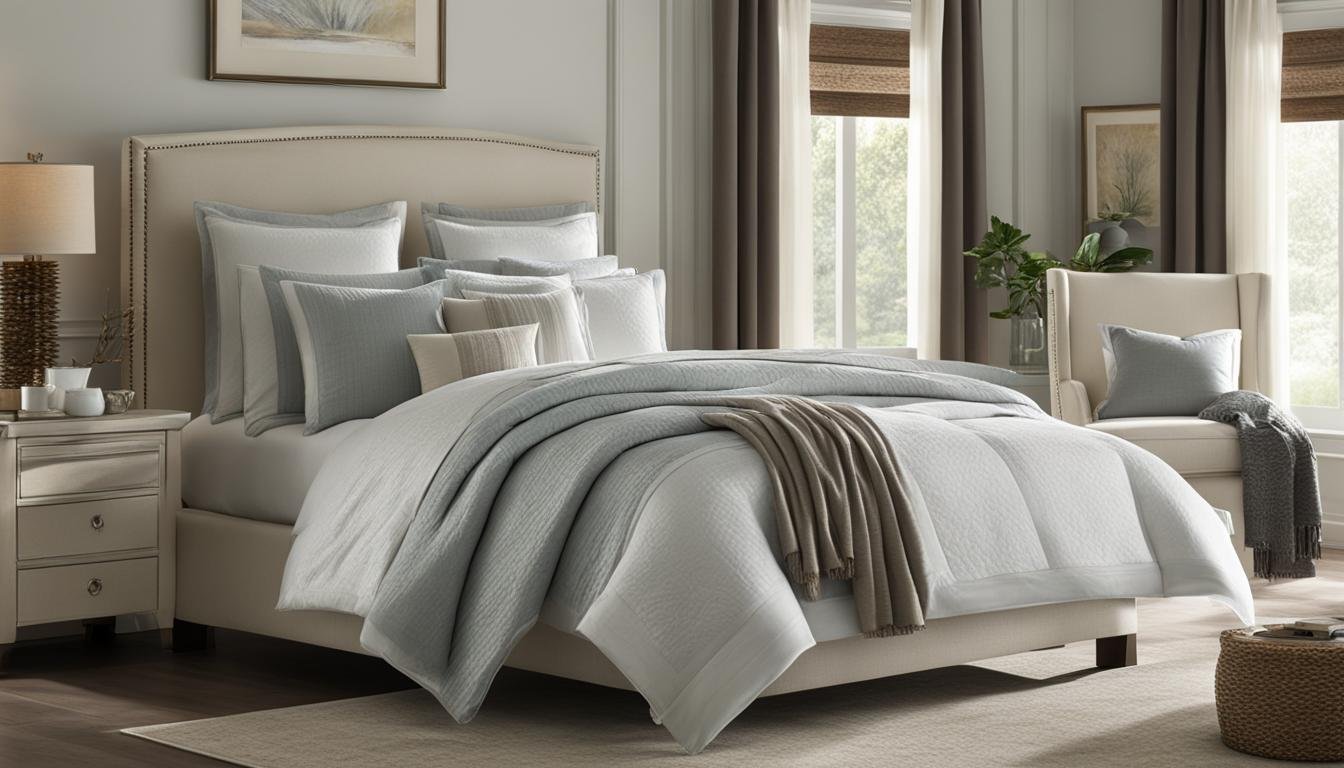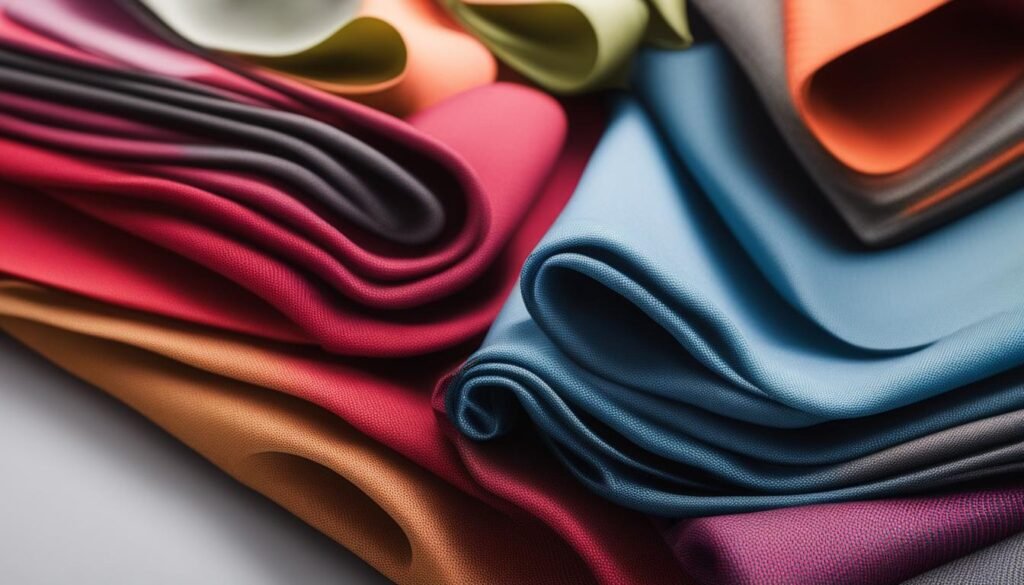Your cart is currently empty!

Breathability & Temp Control Essentials
Imagine immersing into optimal sleep comfort every night, all thanks to advanced temperature-regulating technology designed by NASA and integrated into your bedding. The future is here with the advent of breathable bedding featuring NASA-engineered Outlast® fibers that make a significant difference in your sleep quality. These innovative fibers absorb and release heat, ensuring a comfortable sleep temperature throughout the night.
These cooling sheets balance the perfect blend of technology and comfort and have efficient moisture-wicking capabilities, which aids in reducing sweat and maintaining optimal skin temperature. The Essential Sheet Set made from these fibers has scored high on breathability tests, with customers wholeheartedly validating the superior comfort they offer.
On top of that, these sheets are made of eco-friendly bedding materials and satisfy the requirements of the Oeko-Tex Standard 100 Certification, ensuring a non-toxic, environmentally friendly sleep environment. The high standards maintained in the creation of these sheets lock in their promise of breathability and temperature control for higher-quality sleep.
Key Takeaways
- Temperature-regulating technology is revolutionizing the bedding industry, providing enhanced comfort during sleep.
- NASA-engineered Outlast® fibers are the core element of this technology, effectively regulating temperature by absorbing and releasing heat.
- The moisture-wicking capabilities of these fibers contribute to reduced sweating and optimal skin temperature while sleeping.
- These cooling sheets adhere to the Oeko-Tex Standard 100 Certification, signifying their construction from eco-friendly and non-toxic materials.
- Customers attest to the benefits of these antibacterial and temperature-regulating sheets, emphasizing the importance of breathability in bedding for achieving optimal sleep comfort.
Understanding the Science of Breathability and Temperature Regulation
When considering fabrics, breathability is a key attribute to consider, signifying the fabric’s capacity to allow for moisture vapour transmission. Understanding the science of breathability sheds light not only on fabric characteristics but also on crucial considerations related to body comfort, health, and temperature regulation.
Moisture Vapor Transmission Rate (MVTR) Explained
At the heart of breathability is the Moisture Vapor Transmission Rate or MVTR. This metrics, the gage of how effectively moisture passes through a fabric, plays a monumental role in ensuring comfort by preventing the accumulation of sweat, thereby eliminating the dampness that affects the performance of inner layers, rain gear, or shelter materials.
Incorporating a range of factors such as ventilation in fabrics, waterproof-breathable technology, and the humidity differential between environments, MVTR provides a comprehensive understanding of the ability of fabrics to adapt to changing climate conditions.
Comparing Fabric Technologies: From Outlast® to Omni-Dry
Diverse technologies, including pioneering solutions like Outlast® and Omni-Dry, aim to enhance MVTR to maximize the breathability of fabrics.
Outlast® technology, for instance, adopts a proactive temperature regulation strategy, absorbing, storing, and releasing body heat for optimal thermal comfort. On the other hand, Omni-Dry utilises moisture-wicking yarns that facilitate rapid evaporation, enforcing the ‘stay dry’ principle fundamental to any outdoor adventure.
Why High Breathability Matters for Comfort and Health
Breathable fabric is more than just a comfort enhancer; it’s a health promoter. By permitting a differential in humidity, breathable fabrics facilitate the movement of moisture from high to low humidity environments, keeping the wearer dry and comfortable.
This improved fabric breathability, in turn, fosters proactive temperature regulation and mitigates issues such as sweat-induced cooling, significantly enhancing comfort and contributing to better health, especially during outdoor activities.
Key Factors Influencing The Performance of Breathable Fabrics
Breathability limitations and moisture wicking are integral aspects that determine the overall performance of breathable fabrics. However, numerous factors can negatively impact these attributes, thus affecting the gear performance. It’s crucial to recognize these aspects and set realistic fabric expectations.
One of the key factors influencing breathability is environmental humidity. As the external humidity rises, the fabric’s breathability diminishes. This reduction occurs since saturated air has less capacity to absorb additional moisture. To effectively manage breathability in high humidity conditions, users need to opt for fabrics renowned for advanced moisture wicking capabilities. This attribute allows fabrics to draw moisture away from the skin to the exterior surface, thereby promoting faster evaporation and maintaining comfort.

Another potential disruptor to fabric breathability stems from the compromise of Durable Water Repellent (DWR) finishes. When fabric “wets out,” or becomes water-saturated due to a compromised DWR layer, its breathability is critically impeded. The crucial advantage of DWR finishes is not only to resist water absorption but also to retain fabric breathability by preventing excessive internal moisture retention. Therefore, restoring the DWR finish is vital to preserving fabric breathability and optimizing gear performance.
Remember: Breathable fabrics, while advanced, have limitations. Understanding these limitations allows users to select the right gear that suits various environmental conditions without unfounded expectations of complete protection against nature’s elements.
| Factors Affecting Performance | Impact on Breathability | Ways to Optimize Performance |
|---|---|---|
| Environmental Humidity | As the humidity levels increase, the fabric’s ability to breathe decreases. | Choose fabrics with advanced moisture wicking capabilities. |
| Compromised DWR Finishes | When the DWR finish of a fabric is impaired, it’s breathability reduces significantly. | Restore the DWR layer promptly to retain breathability and prevent moisture build-up. |
| Unrealistic Fabric Expectations | Overstatements regarding fabric capabilities can lead to dissatisfaction and impractical usage. | Understand and accept the limitations of breathable fabrics. |
We cannot control environmental factors, but with precise knowledge and realistic expectations about our gear’s performance, we can greatly enhance our comfort and overall experience.
Optimal Fabrics for Different Climates and Activities
When selecting apparel for high-intensity sporting activities such as running, the choice of fabric is of paramount importance as it significantly impacts performance. Renowned for its durability and breathability, nylon is an excellent choice for running wear. Lightweight running gear made from nylon allows increased comfort during high-tempo activities thanks to its enhanced moisture management.

On the other hand, polyester, another favoured material, boasts unique moisture-wicking properties and is cost-effective. Ideal for maintaining dryness during workouts, polyester sportswear is a staple in temperature-regulating running wear. It allows the skin to breathe and reduces resistance, thereby enhancing overall athletic performance.
Bridging the gap between comfort and functionality, merino wool leads the way in temperature regulation. Impervious to changes in weather conditions, merino wool offers natural breathability, insulation, and odour resistance, making it suitable for both warm and cold climates. For cold weather layering, look no further than merino wool it retains heat even when wet.
Choosing the right breathable fabrics should consider the environmental conditions, balancing between lightweight, flexible materials for warm climates and layered, insulated options for colder settings.
In addition to temperature-regulating properties, care should be taken to select running apparel featuring waterproof outerwear for wet conditions. Breathable, water-resistant materials ensure that athletes remain dry and comfortable, despite the environmental challenges they may face.
In conclusion, the selection of optimal fabrics for different climates and activities is a crucial determinant in improving the overall athletic performance. Fabrics such as nylon, polyester, and merino wool not only provide temperature management options but also facilitate movement, reducing resistance, and optimising comfort.
Conclusion
With a rapidly evolving textile industry and the advent of cutting-edge technology, selecting the right breathable gear for optimum comfort and performance has become a task involving significant research and understanding. Whether you’re looking for sleep comfort or athletic performance, remember that the key lies in finding a balance between approachable fabric technology and practicality. Dive into this section as we explain how you might find the right breathable gear specific to your needs, and how innovation has been a game-changer in improving sleep and sportswear enhancements.
How to Choose the Right Breathable Gear for Your Needs
In determining the right breathable gear, take into account personal comfort, the intended activity, prevailing climatic conditions, and the need for functionality in your apparel or home textiles. Proactive temperature regulation technologies like Outlast® have led to a transformation in the industry of sleep and sportswear. Innovations offer a range of options incorporating practical features like UV protection, antimicrobial properties, and more, that not only enhance comfort but are also eco-friendly.
Advancements in Fabric Technology: Balancing Innovation with Practicality
The fabric industry has seen exponential growth in the area of innovation. With textile advancements, consumers have grown to expect both breathability and other practical features from their selection. The good news is the industry is responding, making a stride towards blending practicality with functionality. Even as the industry continues to grow and innovate, the essence remains that the right breathable fabric could influence your level of comfort and performance significantly, making this a critical factor to consider.
FAQ
What is the relevance of breathability in bedding for optimal sleep comfort?
Breathability is vital in bedding for comfort as it allows for the transfer of moisture, i.e., sweat, away from the human body during sleep. This process prevents the clamminess caused by trapped perspiration and allows for temperature regulation, contributing to a more comfortable and uninterrupted sleep. Bed sheets made with moisture-wicking materials such as NASA-engineered Outlast® fibers and cotton provide this breathability needed for a good night’s sleep.
What is Moisture Vapor Transmission Rate (MVTR) and why is it important?
Moisture Vapor Transmission Rate (MVTR) pertains to the rate at which moisture passes through fabrics. It’s a critical metric for fabric performance as it measures the fabric’s breathability. High MVTR indicates enhanced fabric breathability, which leads to better temperature regulation. Breathability helps maintain comfort and avoid issues associated with trapped moisture like sweat-induced cooling, which can be detrimental during physical activities or when sleeping.
What factors can influence the performance of breathable fabrics?
Several factors can compromise the performance of breathable fabrics. When the external humidity is high, fabric’s breathability diminishes since saturated air has little room for additional moisture. Also, if a fabric “wets out” or becomes water-saturated due to compromised Durable Water Repellent (DWR) layers, breathability is severely inhibited. Restoring the DWR finish is essential to regain fabric breathability and to prevent internal moisture from increasing.
How to choose the right breathable fabric for different climates and activities?
The choice of fabric significantly affects comfort and performance during various activities and in diverse climates. Nylon, known for its durability and breathability, is suitable for running and athletic activities. Polyester, with its moisture-wicking and affordability, is ideal for maintaining dryness during workouts. Merino wool, acknowledged for its natural breathability and odor resistance, is suitable for various climatic conditions. Always consider the environmental conditions and the type of activity when choosing breathable fabrics.
How have advancements in fabric technology impacted sleep and sportswear?
Advances in fabric technology have led to comfort enhancements in both sleep and sportswear products. Materials like Outlast® demonstrate the industry’s shift towards proactive temperature regulation. Innovations in the textile industry have resulted in breathable fabrics that manage moisture and heat, resulting in improved comfort and performance. Consumers today have the option to choose from a variety of options that provide comfort and incorporate practical features like UV protection and antibacterial properties.
Leave a Reply